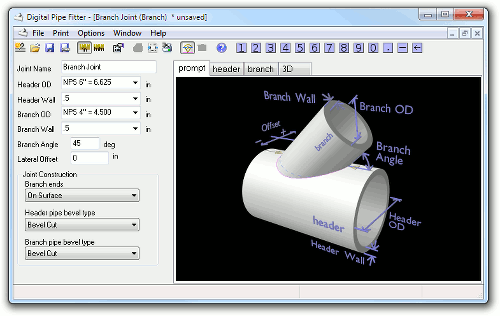The Branch Joint is the intersection of the end of one pipe with the side of another pipe.
The resulting joint is sometimes called a fishmouth or saddle joint.
Two templates are created. One for the end of the branch pipe and another for the side hole or holes in the header pipe.
Parameter Constraints:
Joint Name: name of this joint which is unique to this project or currently opened joints
Header OD: (Outside Diameter) must be a positive number
Header Wall: must be a positive number, less than half Header OD
Branch OD: must be a positive number. For the "On Surface" construction, the Branch OD must be less than or equal to the header inside diameter. For all other constructions, the branch pipe OD must be less than the header pipe inside diameter so that the branch fits inside the header.
Branch Wall: must be a positive number, less than half Branch OD
Branch Angle: more than 0 deg. and no more than 90 deg.
90 deg. is a perpendicular joint
0 deg. is not allowed since the pipes would be parallel.
Lateral Offset: Any positive or negative distance that the branch can be moved sideways where it still intersects with the header pipe. If you want the offset branch pipe to wrap around the header pipe, use an Interference Joint.
Joint Construction:

On Surface: The end of the branch pipe rests on the outside surface of the header pipe. An optional header template can be generated to create a hole through the header pipe based on the interior diameter of the branch pipe.
On Inside Wall: The end of the branch pipe extends through a wall of the header pipe. The pipe is cut such that its end aligns with the inside surface of the header pipe such that no restriction of flow will occur inside the header pipe.
Inside Header Pipe: The branch pipe extends all the way through the wall of the header pipe and ends at the centerline of the header pipe. No cut template is generated for the branch pipe.
On Far Inside Wall: The branch pipe extends all the way through a hole in the wall of the header pipe and further so that it rests on the far inside surface of the header pipe.
On Far Outside Wall: The branch pipe extends all the way through the wall of the header pipe and continues through the other side of the header pipe and ends at the exterior far surface of the header pipe.
All the Way Through: The pipe extends all the way through two holes on both sides of the header pipe. No cut template is generated for the pipe.
Joint Construction Notes:
For an "On Inside Wall" or "On Far Outside Wall" construction, the header template is sized to fit snug around the cut end of the branch pipe. There will never be a gap between the branch pipe and header pipe no matter what the configuration. The best example of this optimization is when both pipes' bevel type is set to 'Perpendicular Cut'.

